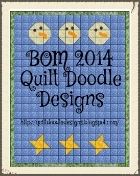No-Melt Mylar Template material is a great tool for making simple applique shapes, such as circles for berries, petals, and fruit as well as simple leaf shapes. The method I'll show you here uses spray starch--the heat from the iron would melt most plastics, but no-melt mylar will hold up to two or three uses before the plastic begins to warp a bit.
Two brands of no-melt mylar are Dritz and Wrights, and the plastic is sold in sheets. JoAnn's and many other quilting and craft stores carry at least one brand, usually in the quilting notions section of the store.
The first step is to trace the applique shape onto the plastic. Since the plastic is opaque, the shape can usually be easily seen through the material for tracing. The difficulty is finding a pen, pencil, or other method that will work on the plastic. I often use a fine line permanent marker, although the ink requires a certain amount of "setting" time to dry and will wipe off with use. Here in the photo below, I've drawn simple petal shapes on the mylar.
Next, cut the mylar shapes and trace them onto the "wrong" side of the fabric. Many of the shapes that work well with mylar have no "right" or "wrong" side, but be aware that you may need to determine which way to flip the mylar template with any directional pieces.
Once the shape of the template is traced, trim the fabric approximately 1/4" outside the drawn line. Using a simple gathering/basting stitch, run a single thread as close to the cut edge as possible without risking fabric fraying--usually a little more than 1/8" outside the drawn line.
Make sure to leave "tails" for tying at the beginning and at the end.
Place the template in the center of the fabric and gather the stitches by pulling on both "tails." Keeping the thread as tightly gathered as possible, knot the ends.
The "right" side of the prepared piece should be smooth of wrinkles and gathers.
Once all of the pieces are prepared to this point, get out the spray starch and a towel or piece of fabric to protect your ironing surface from starch build up. Set the iron on the cotton setting. Spray applique pieces front and back, spraying rather heavily; let starch soak into the fabric. Press with hot iron front and back until they are fairly dry to touch.
Set the pieces aside and allow to completely dry.
Sorry this photo is a bit fuzzy, but once the starched fabric is completely dry, snip the gathering thread and pop out the template plastic. The fabric should maintain its shape fairly well.
The same method can be used for leaves or other oblong shapes with gentle curves. I find that beginning my gathering stitch at the flatter "top" part of the leaf yields the best results.
Applique pieces prepared in this manner can be sewn in a number of ways. One of the applications is as I've used them here--pinning the shapes in place and sewing them onto a background while quilting all layers at the same time.
One final tip--save your plastic template pieces to reuse in other projects and designs. Happy appliqueing!





















8 comments:
Thank you! I can't wait to try this method. Excellent tutorial.
Good stuff...thanks Kim.
Thanks for a great tutorial!! I love your "cherries and more"!! Glad to hear your mom is on the mend.
You are brilliant! Thanks for the tutorial/show & tell!
Thanks for the tutorial. I see what I'm doing wrong now.
Chris
Your tutorial is great.
I do machine applique, although I do know how to hand applique. It's so relaxing.
Finally - I have purchased some no melt Mylar plastic sheets. Going to try making some templates for the remaining Country Cottages in the BOM that we are doing. I will let you know how it works for me. Thanks for the tut.!
I know this is an old thread, but would the quilters no melt template work as a sturdy bottom of a purse?? Many thanks!
Jocelyn
Post a Comment